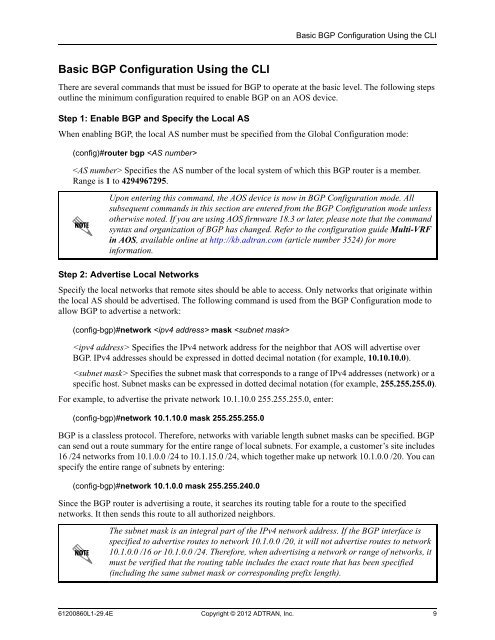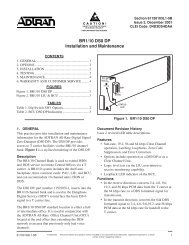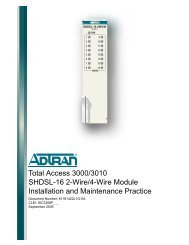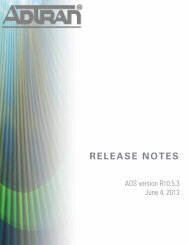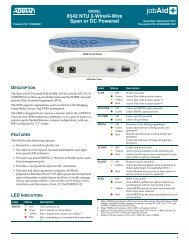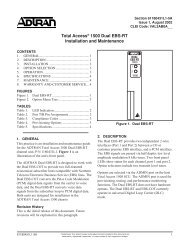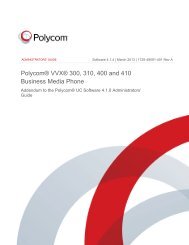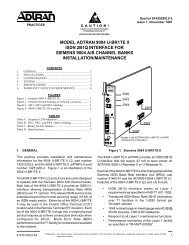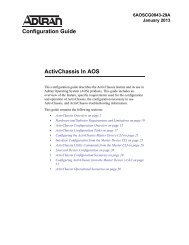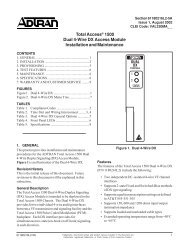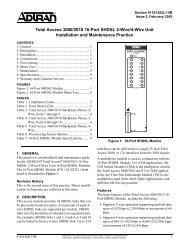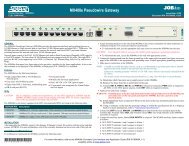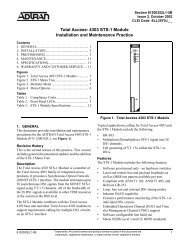View - ADTRAN Support Community
View - ADTRAN Support Community
View - ADTRAN Support Community
You also want an ePaper? Increase the reach of your titles
YUMPU automatically turns print PDFs into web optimized ePapers that Google loves.
Basic BGP Configuration Using the CLI<br />
Basic BGP Configuration Using the CLI<br />
There are several commands that must be issued for BGP to operate at the basic level. The following steps<br />
outline the minimum configuration required to enable BGP on an AOS device.<br />
Step 1: Enable BGP and Specify the Local AS<br />
When enabling BGP, the local AS number must be specified from the Global Configuration mode:<br />
(config)#router bgp <br />
Specifies the AS number of the local system of which this BGP router is a member.<br />
Range is 1 to 4294967295.<br />
Upon entering this command, the AOS device is now in BGP Configuration mode. All<br />
subsequent commands in this section are entered from the BGP Configuration mode unless<br />
otherwise noted. If you are using AOS firmware 18.3 or later, please note that the command<br />
syntax and organization of BGP has changed. Refer to the configuration guide Multi-VRF<br />
in AOS, available online at http://kb.adtran.com (article number 3524) for more<br />
information.<br />
Step 2: Advertise Local Networks<br />
Specify the local networks that remote sites should be able to access. Only networks that originate within<br />
the local AS should be advertised. The following command is used from the BGP Configuration mode to<br />
allow BGP to advertise a network:<br />
(config-bgp)#network mask <br />
Specifies the IPv4 network address for the neighbor that AOS will advertise over<br />
BGP. IPv4 addresses should be expressed in dotted decimal notation (for example, 10.10.10.0).<br />
Specifies the subnet mask that corresponds to a range of IPv4 addresses (network) or a<br />
specific host. Subnet masks can be expressed in dotted decimal notation (for example, 255.255.255.0).<br />
For example, to advertise the private network 10.1.10.0 255.255.255.0, enter:<br />
(config-bgp)#network 10.1.10.0 mask 255.255.255.0<br />
BGP is a classless protocol. Therefore, networks with variable length subnet masks can be specified. BGP<br />
can send out a route summary for the entire range of local subnets. For example, a customer’s site includes<br />
16 /24 networks from 10.1.0.0 /24 to 10.1.15.0 /24, which together make up network 10.1.0.0 /20. You can<br />
specify the entire range of subnets by entering:<br />
(config-bgp)#network 10.1.0.0 mask 255.255.240.0<br />
Since the BGP router is advertising a route, it searches its routing table for a route to the specified<br />
networks. It then sends this route to all authorized neighbors.<br />
The subnet mask is an integral part of the IPv4 network address. If the BGP interface is<br />
specified to advertise routes to network 10.1.0.0 /20, it will not advertise routes to network<br />
10.1.0.0 /16 or 10.1.0.0 /24. Therefore, when advertising a network or range of networks, it<br />
must be verified that the routing table includes the exact route that has been specified<br />
(including the same subnet mask or corresponding prefix length).<br />
61200860L1-29.4E Copyright © 2012 <strong>ADTRAN</strong>, Inc. 9


